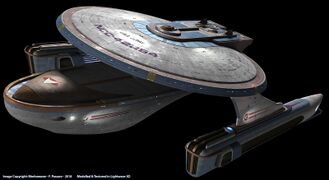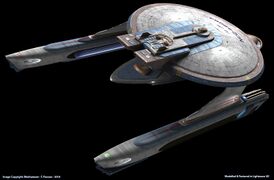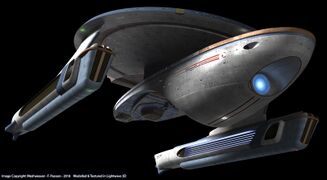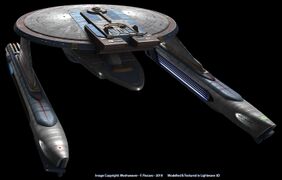Difference between revisions of "Curry Class"
CrimsonTacit (talk | contribs) m (CrimsonTacit moved page User:CrimsonTacit/Sandbox/Curry Class to Curry Class) |
CrimsonTacit (talk | contribs) |
||
| (3 intermediate revisions by the same user not shown) | |||
| Line 4: | Line 4: | ||
| name = Curry | | name = Curry | ||
| affiliation = [[United Federation of Planets]] | | affiliation = [[United Federation of Planets]] | ||
| operator = [[Starfleet]] | | operator = *[[Starfleet]] (Former) | ||
*[[Starfleet Auxiliary]] | |||
| status = Decommissioned | | status = Decommissioned | ||
| role = Utility Cruiser | | role = Utility Cruiser | ||
| Line 42: | Line 43: | ||
| aux = | | aux = | ||
| msd = | | msd = | ||
| | | | ||
}}The '''''Curry''-class utility cruiser''' is a limited-production class of support vessels derived from components of the [[Excelsior Class|''Excelsior''-class heavy cruiser]] and [[Miranda Class|''Miranda''-class frigate]]. Developed in the 2320s, these ships are capable of towing other vessels or cargo containers at warp speeds and possess significant internal cargo capabilities. By 2381, the remaining vessels of this class were transferred to the Starfleet Auxiliary. | }}The '''''Curry''-class utility cruiser''' is a limited-production class of support vessels derived from components of the [[Excelsior Class|''Excelsior''-class heavy cruiser]] and [[Miranda Class|''Miranda''-class frigate]]. Developed in the 2320s, these ships are capable of towing other vessels or cargo containers at warp speeds and possess significant internal cargo capabilities. By 2381, the remaining vessels of this class were transferred to the [[Starfleet Auxiliary]]. | ||
==Science and Exploration== | ==Science and Exploration== | ||
| Line 62: | Line 63: | ||
==Shipboard Life== | ==Shipboard Life== | ||
For their time, ''Curry''-class starships were a comfortable posting, as they had the same accommodations as the ''Excelsior'', but this standard of accommodation remained stagnant throughout the 24<sup>th</sup> century. For instance, those vessels that remain in service in the Starfleet Auxiliary now have holodecks, but that was never a feature they were equipped with during their prior service. A forerunner to the ''California''-class utility cruisers, these ships were one of the first support vessels intended to operate with cruiser-sized crews, and so service on a ''Curry'' feels like service on any other Federation ship, without some of the isolation and claustrophobia that often come with life on a tanker or freighter.<gallery mode="packed"> | For their time, ''Curry''-class starships were a comfortable posting, as they had the same accommodations as the ''Excelsior'', but this standard of accommodation remained stagnant throughout the 24<sup>th</sup> century. For instance, those vessels that remain in service in the Starfleet Auxiliary now have holodecks, but that was never a feature they were equipped with during their prior service. A forerunner to the [[California class|''California''-class utility cruisers]], these ships were one of the first support vessels intended to operate with cruiser-sized crews, and so service on a ''Curry'' feels like service on any other Federation ship, without some of the isolation and claustrophobia that often come with life on a tanker or freighter.<gallery mode="packed"> | ||
File:CURRY1.jpg | File:CURRY1.jpg | ||
File:CURRY2.jpg | File:CURRY2.jpg | ||
Latest revision as of 15:14, 10 April 2023
The Curry-class utility cruiser is a limited-production class of support vessels derived from components of the Excelsior-class heavy cruiser and Miranda-class frigate. Developed in the 2320s, these ships are capable of towing other vessels or cargo containers at warp speeds and possess significant internal cargo capabilities. By 2381, the remaining vessels of this class were transferred to the Starfleet Auxiliary.
Science and Exploration
Curry-class starships have only ever been used for incidental exploratory missions, such as checking out an unusual signal en route to one of their other destinations. They are equipped with a standard suite of four general science labs and a downgraded suite of sensors compared to the Excelsior. In their current role in the Starfleet Auxiliary, any scientific functions they perform are generally limited to resource prospecting or space lane mapping.
Diplomacy
Curry-class starships were used for second-contact missions on a regular basis during their time in service with the exploratory corps, installing subspace relay stations and helping new worlds connect with the Federation. In service of this goal, they retained the officers’ lounge and a few of the other diplomatic comforts found aboard Excelsior-class heavy cruisers. In general, Starfleet preferred to use more prestigious ships for diplomatic duties where possible. In their present role, they are not used for diplomatic functions per se, though they may be used to transport humanitarian supplies and other cargos that might fall under the Federation’s broader diplomatic agenda.
Engineering
Though derived from sections of the Excelsior spaceframe with additional components from the Miranda, namely the nacelles, the Curry differs substantially in its external and internal configuration from its parent classes. Compared to the Excelsior, the saucer section has been moved aft and the interconnecting dorsal (the “neck”) sits amidships connecting the center of the secondary hull to the center of the primary hull. The combined warp-impulse reactor assembly was reworked substantially from the Excelsior to provide full warp power without needing the long vertical core extending into the secondary hull. This assembly feeds two Miranda-type nacelles, which were selected to reduce the maintenance needs of this craft and to balance the ship’s warp field dynamics. The result is a vessel that is capable of smooth acceleration to moderate cruising speeds while towing large objects, rather than the high performance found aboard the Excelsior.
The Curry carries two industrial-sized tractor-beam emitters on the stern, as well as mounting points to pull cargo containers with a physical connection. It maintains the large cargo/shuttle complex found aboard the Excelsior in the undercut of the stern, but this area can become blocked when towing. The secondary shuttle bay has been brought to the bow of the secondary hull to make it easier for the ship to deploy shuttles while towing objects astern. The secondary hull contains additional cargo storage areas thanks to space gained from omitting the primary warp core.
As a transport, it can easily move enough materials and colonists to set up a basic outpost. Its tractor beams made it a common choice during the early decades of the 24th century to move large modular starbase components from system to system as well. The ship’s own maintenance needs are reduced from the Excelsior, but it maintains a similarly sized engineering department to handle construction projects.
Tactical
The Curry retains the ten saucer-mounted phaser emplacements (five dorsal and five ventral) from the Excelsior, and the two forward torpedo launchers in the secondary hull but omits the remainder of the Excelsior’s armaments. It was never intended to engage in combat deliberately, but a relatively heavy armament (for the era) was maintained to deter anyone who might think about attempting to steal her cargo. These ships were used as battlefield tugs during the Dominion War and several were heavily damaged, but they had a greater survivability rate than the smaller Miranda.
Shipboard Life
Curry-class History
The Ptolemy-class refit tug/utility cruiser had been competent vessels for Starfleet Transport Command and the Starfleet Corps of Engineers into the start of the 24th century, but Starfleet ordered a new design that would incorporate Excelsior-era technology starting in 2312. A Tellarite design group was selected for this project, which involved reconfiguring Excelsior-class hull components to better suit a logistics-focused mission. The resulting design, dubbed the Curry, was seen as unusual but greenlit anyway. Production proceeded smoothly, and Starfleet was particularly pleased with the class’s excellent tractor-beam capabilities. The shakedown cruise proceeded without incident and Starfleet placed an order for two dozen Curry-class ships in 2322.
These ships were never a high priority at Starfleet yards, however, as their components were almost always in higher demand by Excelsior and Miranda-class vessels. Indeed, it was found that while superior to the Ptolemy on paper, this new design did not actually add that much more capability for its expanded cost—it was relatively easy to refit older Miranda-class ships into Ptolemy-class ships, but the same could not be said of the Curry because of how different its internal structure was from the Excelsior. And, while Starfleet does not officially prioritize aesthetics, the lines of the Curry were universally seen to be ungraceful at best. Production on the Curry concluded in 2327 with all 24 complete, but this was to be it for this odd duck.
Curry-class starships remained in service with Starfleet for the majority of the 24th century, seeing many second contacts, colony support missions, and other low-level assignments in relative obscurity. Indeed, those officers who saw them often assumed each individual ship was a one-off cobbled together from spare parts. This class served well during the Cardassian, Borg, and Dominion conflicts in a support role, but was sidelined even further by the California-class in the middle of the century. While their core engineering was sound they were now redundant to Starfleet’s core missions, and it was decided that the class would be transferred wholesale to the Starfleet Auxiliary, which was accomplished by 2381. Though under the Auxiliary banner, several ships of this class participated in the Romulan Evacuation project under Admiral Picard and the subsequent clean-up efforts on Mars.
The Curry class In-Play
- This unusual design in canon seems to play some sort of utility role, and we have extrapolated that the change in its design from the Excelsior is to allow it to serve better as a tug or transport.
- This could be seen as a forerunner to the California, but with a much smaller number of ships in the class. They’re for towing and other engineering projects.
- By the current era in Bravo Fleet canon, these ships are no longer in exploratory Starfleet service but can be found in the Starfleet Auxiliary.



